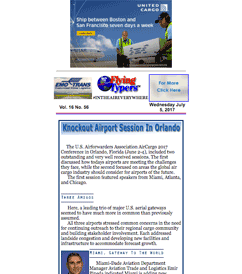 |
As FlyingTypers went to press, a startling 11.3 percent year-on-year growth in exports
recorded by China in June caught most analysts off-guard. Following the
acceleration—led by exports of electronics and high-tech products
to the EU, U.S., and Japan—HSBC predicted “stronger global
demand will support export growth [from China] in the coming quarters.”
Indeed, the export outlook is bright across
Asia. Certainly, the latest Purchasing Manager Index readings suggest
solid demand in the coming months.
 “After a couple of months of fizzle, exports are again showing some
sizzle,” said HSBC economist Frederic Neumann. “Across Asia,
with the lone exception of Korea, new export orders expanded [in June].
Possibly, we are catching the early part of the iPhone production ramp-up.
“After a couple of months of fizzle, exports are again showing some
sizzle,” said HSBC economist Frederic Neumann. “Across Asia,
with the lone exception of Korea, new export orders expanded [in June].
Possibly, we are catching the early part of the iPhone production ramp-up.
“It’s all consistent with a
fairly decent summer.”
The good news on forward demand comes hot
on the heels of a positive May. Although Drewry’s East-West Airfreight
Price Index dropped by 3.1 percent month-on-month due to lower rates on
Asia to North America lanes, the index was still 5.3 percent higher in
May 2017 than a year earlier. Drewry believes this indicates “strong
underlying market fundamentals” and expects “airfreight rates
to rebound in June.”
WorldACD recorded a year-on-year increase
in chargeable weight of 12.8 percent in May and concluded “macro-economic
indicators seem to hint that the present situation looks fairly robust.”
The air freight analyst said growth in
e-commerce may be one factor explaining the surge in cargo witnessed since
the second half of 2016. “Yet, we do not see this trend reflected
in large increases in express air cargo,” added WorldACD. “We
note the largest growth in regular shipments weighing more than 1,000
kilograms, a clear sign that most e-commerce finds the regular speed of
air cargo good enough, and that e-commerce is definitely not a matter
of individual small parcels flying across the globe.”
The Association of Asia Pacific Airlines
(AAPA) also said volumes remained buoyant in May. Asian carriers saw international
air cargo demand, as measured in freight ton kilometer (FTKs), register
a solid 12.2 percent year-on-year increase, while the average international
freight load factor also rose significantly, by 4.7 percentage points
to 65.6 percent, following a comparatively modest 4.3 percent expansion
in offered freight capacity.
IATA’s latest figures revealed that
global air cargo demand, also measured in FTKs, grew 12.7 percent year-on-year
in May 2017. Significantly, this was up from the 8.7 percent annual growth
recorded in April 2017 and was more than three times higher than the five-year
average growth rate of 3.8 percent.
IATA took the view that the continued expansion
of air freight demand was consistent with an improvement in world trade
and new global export order readings, which remained close to six-year
highs in May. However, IATA warned that there were signs that the cyclical
growth period may now have peaked. “The global inventory-to-sales
ratio, for example, has started rising,” said IATA. “This
indicates the period when companies look to re-stock inventories quickly,
which often gives air cargo a boost, has ended.
“Regardless of these developments,
the outlook for air freight is optimistic with demand expected to grow
at a robust rate of 8 percent during Q3 2017.”
IATA noted the element of downside demand
risk in Q3, which was also borne out by the June survey results for the
APAC Forwarding Index produced by Mike King & Associates and Logistics
Trends & Insights LLC. This revealed that the 3-month air freight
outlook took a downward turn in June with only 22.6 percent of survey
respondents anticipating ‘higher’ volumes in the next three
months. 38 percent indicated ‘lower’ volumes while 39.4 percent
anticipated the ‘same’ volumes.
“In the next three months there will
be growth in air cargo, but we expect rates to be flat,” said one
respondent.
Geoffrey |





